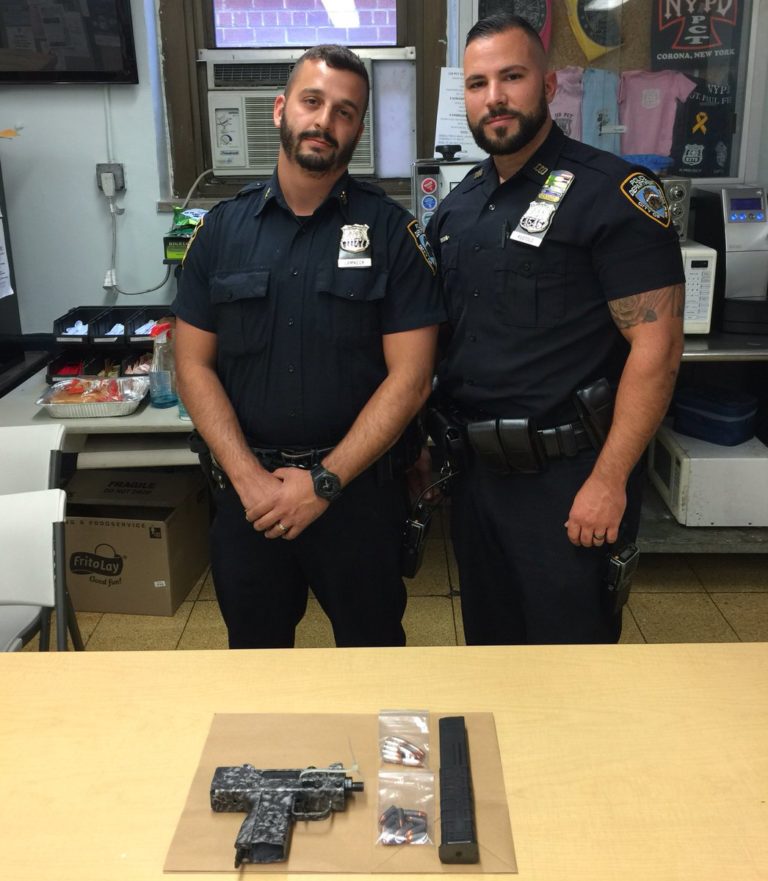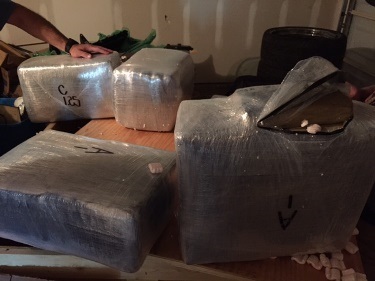Eight Individuals Of Purported Rival Gangs Shot Allegedly By Multiple “Pop On Site” Gang Members; Defendants Allegedly Bragged About Shootings on Social Media Before And After Incidents
Queens District Attorney Richard A. Brown, joined by New York City Police Commissioner William J. Bratton, today announced that a Queens County grand jury has indicted 18 alleged members and associates of the violent Far Rockaway street gang known as “Pop On Site” (“POS”) – which is also known as “Fully Loaded Outta Control Crips” (“FLOCC”) and “Young Flocc Boys” (“YFB”) – on charges of conspiring to murder and assault members of rival street gangs, as well as conspiring to acquire firearms in order to assert and maintain control over a section of Rockaway Beach that they consider their territory and to seek revenge for the shooting of their own members.
District Attorney Brown said, “The defendants are variously accused of turning neighborhood streets into a war zone by acting in concert with one or more of their co-defendants to shoot and wound eight individuals over a one-year-period between 2014 and 2015. Their alleged criminal and violent and reckless acts have no place in a civilized society.”
District Attorney Brown continued, “This indictment is another example of police and prosecutors working together to eliminate gang violence that too often plagues our neighborhoods and strikes at the heart of a unified and criminally active group of young people who threaten the lives and safety of innocent bystanders.”
“The violence allegedly perpetrated by the defendants in this case is daunting and pervasive,” said Police Commissioner Bratton. Their ingenuity in devising a unique communication code did nothing to impede our investigation. Rather, the full scope of our resources was brought to bear in the name of justice for the residents of Rockaway Beach – securing an indictment against 18 indictments on an array of violent charges. I want to thank the NYPD’s Gun Violence Suppression Division and Violence Reduction Task Force for their resilience and attention to detail throughout this long-term investigation. I also want to recognize the excellent work of our partners at the Queens District Attorney’s Office.”
The 18 defendants – who range in age from 16 to 22 – are alleged to have operated as the POS street gang within the confines of the New York City Police Department’s 100th Precinct, specifically the geographical area of Beach 81st Street to Beach 86th Street between Rockaway Beach Boulevard and Rockaway Freeway in the Queens neighborhood of Rockaway Beach. The criminal charges are set forth in a 90-count indictment. (See Addendum for details on each defendant)
The long-term investigation – which was spearheaded by the New York City Police Department’s Gun Violence Suppression Division, Violence Reduction Task Force, and the Queens District Attorney’s Narcotics Investigations Bureau – utilized various investigative techniques, including the monitoring of telephone conversations and conversations on social media pages belonging to gang members. It is alleged that gang members allegedly discussed on social media shootings that were being planned or bragging afterwards about the shootings. During the course of the conspiracies, POS gang members used a distinctive system of coded language and phrases which allowed them to communicate with one another to elude others and law enforcement. Among this coded language were references to committing shootings, including “drill,” “touched,” “bangout,” and “its litt.” Additionally, code words and phrases were used to refer to firearms, including “hammer,” “bitch,” “Shawty,” and “whoopty.” It was also part of the conspiracies for the indicted defendants to keep incarcerated members of the POS gang informed of the activities and events related to the gang, including, but not limited to, acts of violence.
According to the indictment, throughout the investigation, prosecutors and members of the NYPD reviewed thousands of pages of social media conversations, images and video. For example, it is alleged that POS member Zameer Khan shot a rival gang member in the left calf and right thigh at approximately 2:00 a.m. on August 2, 2014, leaving five 9mm shell casings and five bullet fragments in front of the shooting location on Beach Channel Drive in Queens. On August 5, 2014, Khan allegedly caused or permitted to be posted on Facebook a message to defendant Unique Wooden asking whether Wooden had heard that Khan shot a rival gang member on Beach Channel Drive. (“Was good bro, yu Hurd bout tht lil movie I made infront the 60es store lml”)
In a 90-count indictment, the 18 defendants, and other members and associates of the POS gang, are accused of conspiring between April 2014 and December 2015 to obtain firearms and to murder or assault rival street gang members from neighboring areas in Far Rockaway for the purpose of asserting dominion and control over their geographical territory, to enhance their status in the POS gang and to retaliate against, but not limited to, 70Gs, Body Squad and Gang of Apes (GOA) gang members.
It is alleged that during the course of the conspiracy, POS members and members of rival gangs 70Gs, Body Squad and Gang of Apes became engaged in a violent gang rivalry, in which POS members assaulted and shot rival gang members and often discussed their efforts and retaliation over social media and in telephone conversations.
It is also alleged that as part of the conspiracy, POS members over 18 years old instructed juveniles – between the ages of 14 and 16 – to murder rival gang members, to engage in acts of gun violence and physical violence against rival gang members and to carry or use firearms for the older POS members.
Eleven of the defendants were arraigned yesterday before Queens County Supreme Court Justice Robert Kohm. The defendants were: Unique Wooden, Romello Grey, Deion Lowery, Qwavon Harris, Quentin Lowery, Taquan Brathwaite, David Miley, Keith Brown, Issiah Yusef, Jermaine Mackey and Dwayne Lyttle. Bail was variously set at $250,000 to $550,000 with a bail sufficiency hearing for each defendant (see Addendum for details).
The investigation was conducted by the NYPD’s Gun Violence Suppression Division, Violence Reduction Task Force with Detective Douglas Rome as the case officer, under the supervision of Sergeant Kevin McLaughlin, Lieutenant Richard Zacarese and the overall supervision of Assistant Chief James Essig, Commanding Officer of the Gun Violence Suppression Division.
Assistant District Attorney Julie S. Trivedi, Chief of the Violent Criminal Enterprises Unit within District Attorney Brown’s Narcotics Investigations Bureau, and Assistant District Attorney Mark L. Katz, Deputy Narcotics Investigation Bureau Chief, are prosecuting the cases under the supervision of Assistant District Attorney Wilbert J. LeMelle, Bureau Chief, and the overall supervision of Executive Assistant District Attorney for Investigations Peter A. Crusco and Deputy Executive Assistant District Attorney for Investigations Linda M. Cantoni.
It should be noted that an indictment is merely an accusation and that the defendants are presumed innocent until proven guilty.
ADDENDUM
Zameer Khan (a.k.a. Za), 21, of Far Rockaway, is charged with first-, second-, third- and fourth-degree conspiracy, second-degree attempted murder, first-degree criminal use of a firearm, second-degree criminal possession of a weapon, second-degree assault and criminal possession of a firearm.
Unique Wooden (a.k.a. Gunz), 21, of Far Rockaway, is charged with first-, second-, third- and fourth-degree conspiracy, second-degree attempted murder, second-degree criminal possession of a weapon, second-degree assault and criminal possession of a firearm. Bail was set at $550,000 with a bail sufficiency hearing.
Romello Grey (a.k.a. Seven), 16, of Far Rockaway, is charged with second- and fourth-degree conspiracy, second-degree attempted murder, second-degree criminal possession of a weapon, second-degree assault and criminal possession of a firearm. Bail was set at $500,000 with a bail sufficiency hearing.
Deion Lowery, (a.k.a. Eight), 19, of Far Rockaway, is charged with first-, second-, third- and fourth-degree conspiracy, second-degree attempted murder, first-degree criminal use of a firearm, second-degree criminal possession of a weapon, first-degree attempted assault, second-degree assault, first- and second-degree reckless endangerment and criminal possession of a firearm. Bail was set at $500,000 with a bail sufficiency hearing.
Qwavon Harris (a.k.a. Qwa), 21, of Far Rockaway, is charged with first-, second-, third- and fourth-degree conspiracy, second-degree attempted murder, first-degree criminal use of a firearm, second-degree criminal possession of a weapon, first-degree attempted assault, second-degree assault and criminal possession of a firearm. Bail was set at $500,000 with a bail sufficiency hearing.
Quentin Lowery (a.k.a. Seven), 19, of Far Rockaway, is charged with first-, second-, third- and fourth-degree conspiracy, second-degree attempted murder, first-degree criminal use of a firearm, second-degree criminal possession of a weapon, second-degree assault, criminal possession of a firearm and second-degree reckless endangerment. Bail was set at $500,000 with a bail sufficiency hearing.
Taquan Brathwaite (a.k.a. Burna), 20, of Far Rockaway, is charged with first-, second-, third- and fourth-degree conspiracy, second-degree attempted murder, second-degree criminal possession of a weapon, second-degree assault and criminal possession of a firearm. Bail was set at $500,000 with a bail sufficiency hearing.
Cyrenious Williams (a.k.a. Cy), 20, of Far Rockaway, is charged with first-, second-, third- and fourth-degree conspiracy, second-degree attempted murder, second-degree criminal possession of a weapon, first-degree attempted assault, second-degree assault, first- and second-degree reckless endangerment and criminal possession of a firearm.
David Miley (a.k.a. Milly), 17, of Far Rockaway, is charged with second- and fourth-degree conspiracy, second- degree attempted murder, second-degree criminal possession of a weapon, second-degree assault and criminal possession of a firearm. Bail was set at $500,000 with a bail sufficiency hearing.
Anthony Turner, (a.k.a. Bhe Jay), 21, of Far Rockaway, is charged with first-, second-, third- and fourth-degree conspiracy, second-degree attempted murder, second-degree criminal possession of a weapon, second-degree assault and criminal possession of a firearm.
Dante Hunter (a.k.a. Demon, Inferno), 17, of Far Rockaway, is charged with second- and fourth-degree conspiracy, second-degree attempted murder, first-degree criminal use of a firearm, second-degree criminal possession of a weapon, second-degree assault and criminal possession of a firearm.
Keith Brown (a.k.a. Ko), 20, of Far Rockaway, is charged with first-, second-, third- and fourth-degree conspiracy, second-degree attempted murder, second-degree criminal possession of a weapon, second-degree assault and criminal possession of a firearm. Bail was set at $500,000 with a bail sufficiency hearing.
Jacob Williams, 22, of Far Rockaway, is charged with first-, second-, third- and fourth-degree conspiracy, second-degree attempted murder, second-degree criminal possession of a weapon, second-degree assault and criminal possession of a firearm.
Issiah Yusef, 21, of Far Rockaway, is charged with first-, second-, third-and fourth-degree conspiracy, second- degree attempted murder, second-degree criminal possession of a weapon, first-degree attempted assault, first- and second-degree reckless endangerment and criminal possession of a firearm. Bail was set at $250,000 with a bail sufficiency hearing.
Jermaine Mackey (a.k.a. Maine), 16, of Astoria, Queens, is charged with second- and fourth degree conspiracy, second-degree attempted murder, first-degree attempted assault, first-degree criminal use of a firearm, second- degree criminal possession of a weapon, second-degree assault, first- and second-degree reckless endangerment, criminal possession of a firearm. Bail was set at $500,000 with a bail sufficiency hearing.
Dwayne Lyttle (a.k.a. Wayne), 17, of the Bronx, is charged with second- and fourth-degree conspiracy, second- degree attempted murder, second-degree criminal possession of a weapon, first-degree attempted assault, second-degree assault, first- and second-degree reckless endangerment and criminal possession of a firearm. Bail was set at $500,000 with a bail sufficiency hearing.
Jahmeek Bey-Jones (a.k.a. Jah), 17, of Far Rockaway, is charged with second- and fourth-degree conspiracy, second-degree attempted murder, first-degree criminal use of a firearm, second-degree criminal possession of a weapon, second-degree assault and criminal possession of a firearm.
Armani Wiliams (a.k.a. Lil Flocc, Flocc), 19, of Far Rockaway, is charged with first-, second-, third- and fourth- degree conspiracy, second-degree attempted murder, second-degree criminal possession of a weapon, first- degree attempted assault, first- and second-degree reckless endangerment and criminal possession of a firearm.
The post Reputed Members of Violent NYC Gang Indicted For Conspiring To Commit Murders appeared first on Breaking911.



















